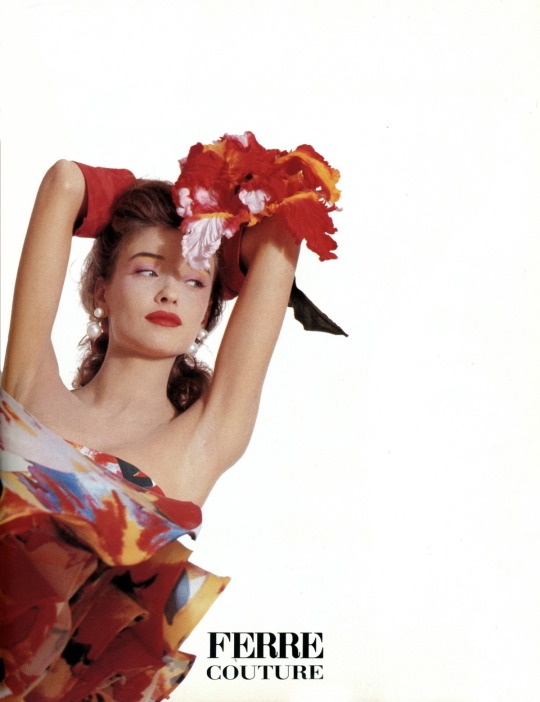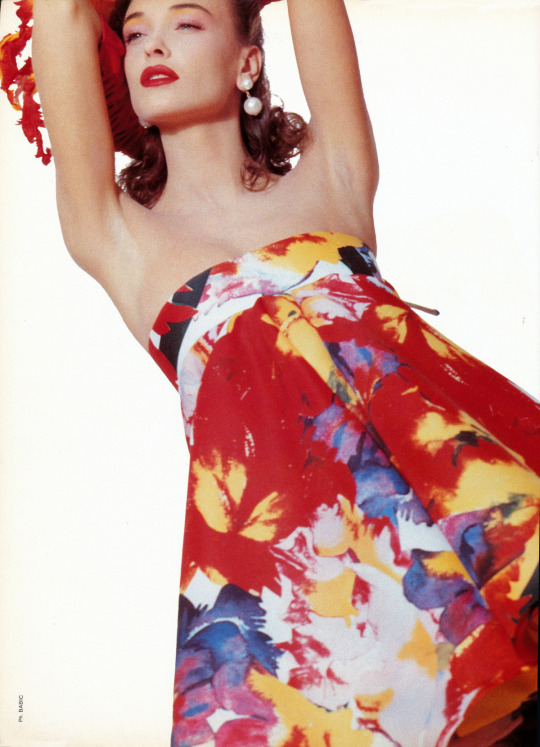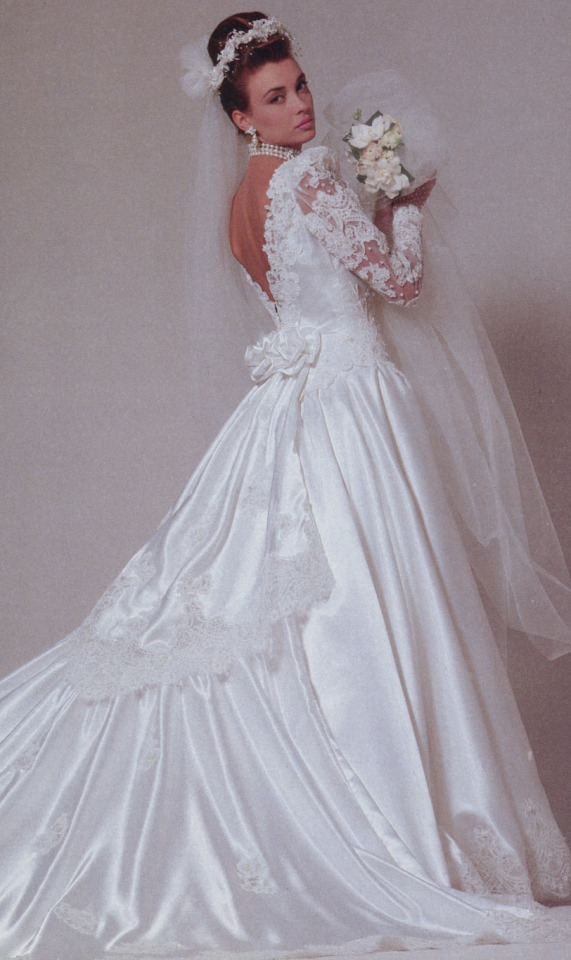#Olatz Lopez
Text


Ferré Couture, 1988.
Model: Olatz López Garmendia.
#olatz lópez garmendia#olatz lopez garmendia#olatz lopez#gianfranco ferré#gianfranco ferre#1988#1980s
68 notes
·
View notes
Text

US Vogue September 1986
Olatz Lopez (Schnabel) in a twisted pantsuit, by Perry Ellis - the jacket, longer and easier; the pants, pleated and shortened at the ankle; all in the most vibrant black and white tiles. Here with this season's cashmere crew-neck top and elegant alligator belt. Hair, Layla D'Angelo, makeup, Leslie Chlkes.
Olatz Lopez ( Schnabel) dans un tailleur pantalon twisté, de Perry Ellis - la veste, plus longue et plus facile ; le pantalon, plissé et raccourci à la cheville ; le tout dans les carreaux noirs et blancs les plus vifs. Ici, avec le haut à col rond en cachemire de la saison et l'élégante ceinture en alligator. Coiffure, Layla D'Angelo, maquillage, Leslie Chlkes.
Photo Mario Testino
vogue archive
#us vogue#september 1986#fashion 80s#1986-87#fall/winter#automne/hiver#perry ellis#layla d'angelo#leslie chlkes#olatz lopez#olatz schnabel#mario testino#pants suit
15 notes
·
View notes
Text

Olatz Lopez Diaz
https://fr-fr.facebook.com/olatz.lopezdiaz
947 notes
·
View notes
Photo

Olatz Lopez Garmendia – Imagen Awards in Los Angeles 08/18/2017 http://ift.tt/2x3wYFt
0 notes
Text
Julian Schnabel - Every Silver Lining Has a Cloud
Julian Schnabel – Every Silver Lining Has a Cloud
Julian Schnabel – (Untitled) Olatz Lopez, 1992, screenprint in 16 colours, signed, numbered, edition of 250 + 25 AP’s, size: 137.2 x 110.5 cm. Price upon request.
About this Artwork
Olatz Schnabel (Lopez), the Basque-born, Paris-raised former model who for over 17 years was Schnabel’s muse and wife. This work is reflecting the Neo-Expressionism inaugurating a return to romantic and poetic…
View On WordPress
#20th Century Art#and Color#Contemporary Art#Engagement with Mass Media#Eric Fischl#Film/Video#Form#Found Objects#Human Figure#Impasto#Individual Portrait#julian schnabel#Large Brushstrokes/Loose Brushwork#Line#Multiple Styles#Neo-Expressionism#Neoexpressionism#New York Artists#Painting#United States#Use of Common Materials
0 notes
Text
Danilo Maldonado Machado, the dissident artist called 'El Sexto,' on art and liberty in Cuba
Danilo Maldonado Machado, the dissident artist called 'El Sexto,' on art
and liberty in Cuba
Carolina A. Miranda
At the tail end of 2014, Danilo Maldonado Machado, the graffiti artist
known as "El Sexto," was detained by the authorities as he made his way
to a public park in Havana to stage a work of protest art. In his
vehicle, he was carrying a pair of pigs that he had painted with the
names of the Castro brothers — one "Raul," the other "Fidel." His plan
was to release them and let members of the public catch them and take
them home.
But the piece, titled "Rebelión en la granja" (after George Orwell's
"Animal Farm) never happened. Instead, Maldonado spent 10 months in
jail. His case drew international headlines. As did a subsequent
detention in which he publicly celebrated the death of Fidel Castro on a
Havana street.
Maldonado now finds himself in the United States where he is promoting
human rights in Cuba in collaboration with the Human Rights Foundation,
which helped sponsor his trip. He is also at work on a pop-up exhibition
that lands in San Francisco in mid-May. "It will feature a variety of
things, like a reconstruction of the cell I was in in Cuba," he says.
"There will be drawings and paintings."
I was interested in graffiti because it was a type of street propaganda.
— Danilo Maldonado Machado, a.k.a. "El Sexto"
The artist was in Los Angeles recently for a one-night show of his
prison drawings at the Stay Gallery in Downey. He also participated in a
panel at the Museum of Tolerance in Los Angeles, in conjunction with a
screening of the documentary "Patria o Muerte: Cuba, Fatherland or
Death," directed by Olatz Lopez Garmendia and executive produced by
Julian Schnabel, that looks at the difficult economic and political
circumstances facing everyday people in Cuba. (Maldonado is featured in
the film.)
In this edited conversation, he discusses why he is drawn to graffiti,
what inspired him to attempt to release a pair of pigs in Havana, and
the children's book he would one day like to write for his daughter.
You have made your reputation as a street artist. How did you get your
start?
I always drew as a kid — always. And I had lessons because my uncle was
an art critic. As an adolescent, though, I got bored with the formal
education in school and wanted to get away from that.
I started noticing the importance of visuals, of propaganda, of how
those things can affect people. [The Cuban government] has appropriated
everything. All of the TV shows are by the government. All of the
newspapers are by the government. All of the billboards are by the
government. I wanted my art to relate to that. I was interested in
graffiti because it was a type of street propaganda.
What were your earliest actions?
"Rewind" — I used to paint the rewind symbol, the two little arrows,
using a stencil. I put it all over the place and they started to erase
it, so I could tell they were keeping an eye on the streets. But I still
chose the street because I didn't have to ask anybody's permission.
How did the name "El Sexto" come about?
It's a joke. Like I said, I'm interested in publicity and propaganda. In
Cuba [in the 1990s], there was this gigantic publicity over this group
called the "Five Heroes" [the Cuban Five] — these five spies that were
arrested in the United States. I thought, if they are the Five Heroes,
then the sixth hero is the people. So I became "El Sexto" — The Sixth. I
started putting it all over the place as a joke, as propaganda.
What inspired "Rebelión en la granja," the performance piece with the pigs?
I'm always looking for a way of grabbing visual space, not just by
graffiti. That's why I do things like transmit live on social media. I'm
trying to invade the visual spaces of others.
Well, in Cuba they do this thing with pigs where it's like a game. They
release some pigs and you pay 20 pesos and you go into this area and
whoever gets the pig, gets the pig. I was like, "I'm going to paint
these pigs green and write their names "Raúl" and "Fidel" on them.
I had them in the truck on my way to the park. I told a friend to get on
the phone and publicize it, so they found out about it and they picked
me up. They accused me of desacato — which is having a lack of respect
for maximum authority. And well, the maximum authorities are the
Castros. They talked about putting me away for three years. I did 10 months.
Your work has a sharp political message, but also humor.
For me, the humor is so important. People want to laugh. And with humor,
you can demystify these people. They have these uniforms that they've
invented for themselves, this status; with humor you can pick it apart.
How do you and your work fit into the broader art scene in Cuba? What
connections do you have to some of the island's better-known artists?
The only thing that is recognized as art there are the things that are
within government institutions. If you are outside of that, it's not
art, it's not anything. The galleries are theirs, the museums are
theirs, the institutions — the ones who will do the paperwork so you can
travel — those all belong to the government.
I have some relationships with some of the "official" artists, but given
my condition, as someone who has been a prisoner, they can't expose
themselves too much by helping me out. I don't judge the decisions that
someone makes in this regard. They have families that they have to take
care of. Everyone has stuff they need to do. I also have family, but I
choose to be free.
How connected are you with Cuban artist Tania Bruguera (who was also
detained for attempting to stage a performance in Havana)? And how do
you feel about international artists becoming involved in Cuban politics?
She's a friend. I worked in a school that she created in Havana [Instar,
the Instituto de Artivismo Hannah Arendt]. The level of what she
represents, it's so important. It's like Julian Schnabel [who spoke out
on my case]. These are people who have international recognition and
they managed to spread the news of what was happening to me in Cuba.
That's what people like Tania can do: They can draw attention to the
cause. Cuba needs the solidarity of the world.
When the dictator died and they picked me up, everyone got right on
social media supporting me. It was really beautiful.
As Cuba and the U.S. reestablish diplomatic relations, has there been an
economic and political opening in your view?
Not really. You have all of these foreign investors, but it doesn't make
much of a difference in the life of the average Cuban. If some company
comes and opens a cafe, they don't pay the employees directly. They pay
the Cuban government, and the government pays the people. And the
official average wage is still $20, $25 a month. People say, "Oh, we
have relations with Cuba now." No, you have relations with the
government of Cuba, not the people.
What works were you exhibiting in Downey?
I was showing some drawings I did in prison — some from the first time
around, when I was arrested for painting the two pigs.
There are some drawings from this last time I was in jail, when [Castro]
died. I had gone out into the street and written "Se fué" (He's gone) as
a graffiti on the building where the revolutionaries had installed
themselves after the revolution triumphed. It was the Hotel Habana
Libre, which before was the Havana Hilton. That graffiti cost me two
months of jail time.
And there were drawings from a small book I started making for children
— for Renata María, my precious girl. She will turn 4 in July.
A political book?
No. It's not about inserting politics. It's very imaginative.
Where I live there is the issue of propaganda and dogma, and they start
it from the youngest age. They are constantly manipulating — there are
these books with drawings that say things like "En manos buenas, un
fusil es bueno" (In good hands, a rifle is good) and feature images of
people dressed in fatigues.
I wanted to do something different. This features magical elements. It
has things about flying through the clouds. It has things that are very
childlike.
What did being in prison teach you about Cuba?
It's that the majority of people who are in jail, even though they
wouldn't consider themselves political prisoners, they are political
prisoners. They are prisoners because they don't work for the state —
and that's dangerous to the state. If you sell peanuts because you don't
want to work for the state's miserable wage, you can end up in prison.
But [the Castros], they've never been held responsible for the crimes
they have committed. On the contrary a lot of people think [Fidel] is
cool. There are a lot of people in Latin America who think he is cool.
But that's not cool. Cool is Ghandi. Cool is Martin Luther King Jr.
+++
[email protected]
@cmonstah
Source: Danilo Maldonado Machado, the dissident artist called 'El
Sexto,' on art and liberty in Cuba - LA Times -
http://ift.tt/2oc4HKC
via Blogger http://ift.tt/2nqr8Nk
0 notes
Text

Modern Bride, 1988.
Model: Olatz López Garmendia.
59 notes
·
View notes
Photo

Olatz Lopez
22 notes
·
View notes
Text

Olatz Lopez Diaz
https://fr-fr.facebook.com/olatz.lopezdiaz
686 notes
·
View notes


